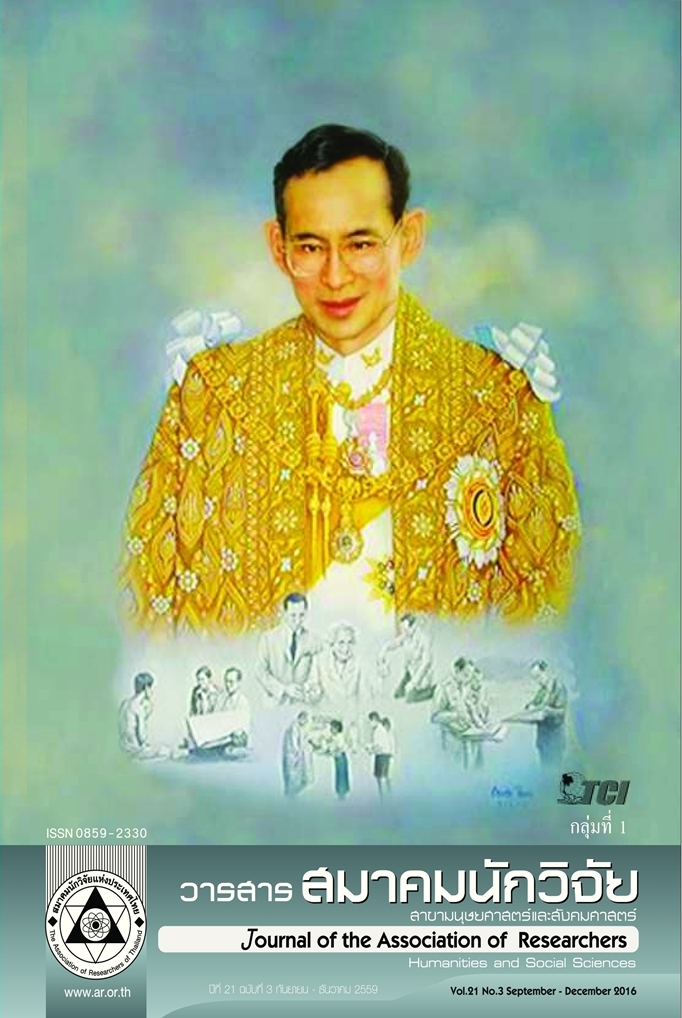Strategic Leadership, Corporate Social Responsibility and Corporate Image of Employees’ of Workpoint Entertainment Public Company Limited: Path Analysis
Main Article Content
Abstract
The purpose of this research study were 1) to study of the structural relationship between Strategic Leadership Corporate Social Responsibility and Corporate image of Workpoint Entertainment Public Company Limited 2) to study direct and indirect effects of Strategic Leadership on Corporate image (by Corporate Social Responsibility) and to study direct effect for Corporate Social Responsibility on Corporate image of Workpoint Entertainment Public Company Limited. The sample research staff were 450 and The number of questionnaire to final analysis 420 with the confidence level 80 percent. The research of 1) The Strategic Leadership ViSTA to positive relationship with Corporate Social Responsibility at the statistical significance 0618, p< 0.01 The Strategic Leadership ViSTA to positive relationship in higher with Corporate image at the statistical significance 0.531, p< 0.01 and Corporate Social Responsibility to positive relationship with Corporate image to medium at the statistical significance 0.423, p< 0.01 2)Strategic Leadership ViSTA have direct effect to Corporate image in higher at the statistical significance (SLgIM, γ = 0.436, p< 0.01) and Corporate Social Responsibility have effect to Corporate image in higher at the statistical significance (CSRgIM, β = 0.154, p< 0.01) indicated Corporate image can predict were to Corporate Social Responsibility overview in very high at the statistical significance. 3) Strategic Leadership ViSTA have effect to Corporate Social Responsibilityin higher at the statistical significance (TFgCOM, γ = 0.618, p< 0.01) and were to proportion of variability can be explain and predict 38.20 percent of variability in Corporate Social Responsibility can be explain and predict by Strategic Leadership ViSTA in higher level. 4) Strategic Leadership ViSTA have indirect effect to Corporate image to Corporate Social Responsibility 0.095 in lower level at the statistical significance (SLgCSRgIM,γβ(0.436X0.154) = 0.095, p< 0.05) and 29.70 percent of variability in Corporate image can be explain and predict by The Strategic Leadership ViSTA can accept Hypothesis at the statistical significance.
Article Details
บทความที่ปรากฏในวารสารนี้ เป็นความรับผิดชอบของผู้เขียน ซึ่งสมาคมนักวิจัยไม่จำเป็นต้องเห็นด้วยเสมอไป การนำเสนอผลงานวิจัยและบทความในวารสารนี้ไปเผยแพร่สามารถกระทำได้ โดยระบุแหล่งอ้างอิงจาก "วารสารสมาคมนักวิจัย"
References
พิพัฒน์ นนทนาธรณ์. (2553). การจัดการความรับผิดชอบต่อสังคมขององค์การ: การสร้างข้อได้เปรียบทางการแข่งขันอย่าง ยั่งยืน. นนทบุรี:
ธิงค์ บียอนด์ บุ๊คส์. (2556). ภาวะผู้นำเชิงปฏิบัติการ: LIFE Model. กรุงเทพมหานคร: ศูนย์ผู้นำธุรกิจเพื่อสังคม.
รัตติกรณ์ จงวิศาล. (2556). ภาวะผู้นำ: ทฤษฎี การวิจัย และแนวทางสู่การพัฒนา. กรุงเทพมหานคร: สำนักพิมพ์แห่ง จุฬาลงกรณ์มหาวิทยาลัย.
References
Asree, S., M. Zain, and M. R. Razalli. (2009). Influence of Leadership competency and organizational culture on responsiveness and performance of firms. Emerald Group Publishing Limited, 500516.
Bollen, K. A. (1989). Structural equations with latent variables. NY: Wiley. A leading, readable text on structural modeling.
Chuan, I. K. (2012). Corporate Social Responsibility: The Opportunity for Strategic Organization Change. Doctor of Philosophy in Organization Development, Benedictine University.
Curran, P. J., S. G. West, and J. F. Finch. (1996). “The robustness of test statistics to nonnormality and specification error in confirmatory factor analysis.” Psychological Methods 1 (1): 16.
Diamantopoulos, A., and J. A. Siguaw. (2000). Introducing lisrel: A guide for the uninitiated (introducing statistical methods series). London: SAGE Publication, Inc.
Duarte, F. (2010). “Working with corporate social responsibility in Brazilian companies: The role of manager’ values in the maintenance of CSR cultures.” Journal of Business Ethics 96(3): 1-14.
Hooper, D., J. Coughlan, and M. R. Mullen. (2008). “Structural Equation Modelling: Guidelines for Determining Model Fit.” Electronic Journal of Business Research Methods 6(1): 53-60.
Phiphat Nonthanathon. (2010). Corporate social responsibility management: Creating a sustainable competitive advantage (in Thai)
______(2013). Operational Leadership: LIFE Model. Bangkok: Operational Socauil Enterprise Leadership Center.
Pisarn Pothongsangarun. (2012). Development of Corporate Social Responsibility Leadership Styles of Sugar Mill Industry Group (in Thai)
Ratikorn Jongwisan. (2016). LEADERSHIP: Theories, Research, and Approaches to Development: Bangkok: Chulalongkorn University Press. (in Thai)
Teeraporn Tongkachok. (2013). The Factors Influencing Corporate Social Responsibility of Listed Companies in the Stock Exchange of Thailand (in Thai)


